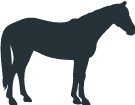Equine motor neuron disease (EMND) is an acquired neurodegenerative disease of the somatic lower motor neurons of adult horses. The disease is characterized by the onset of neurologic dysfunction and muscle wasting resulting from the deterioration of motor neurons and myopathy. The typical age range of affected horses ranges from 15 months old to 25 years and peaks when horses are 16 years old. Both sexes are affected although increased incidents have been documented in Standardbred, Quarter horses, Arabians, and Thoroughbreds.
EMND is considered to be a multifactorial disease, however a dietary deficiency in vitamin E is considered to be a major predisposing factor in its development. This is largely related to when horses have a decreased antioxidant capacity, it leads to accumulation of free radials, and results in oxidative damage to the somatic ventral motor neuron cells.
Clinical signs
The typical clinical signs observed in horses with EMND include progressive weakness, muscle wasting and atrophy, weight loss, abnormal stance, behavioral changes, and muscle fasciculations. Often, clinical signs of EMND don't become obvious until horses have lost approximately 30% of their motor neurons. EMND is diagnosed based on history, clinical signs, and laboratory test findings (obtained through a muscle biopsy).
- Muscle wasting and atrophy: Horses with EMND usually have symmetrical atrophied muscles and weight loss.
- Behavior: Horses with EMND often are characterized as being hyperalert, displaying a worried facial expressions.
- Muscle weakness: May manifest as muscle fasciculations in the head and upper legs, toe dragging, low head and neck carriage, and exercise intolerance.
- Abnormal standing position: Although it is actually a manifestation of muscle weakness, horses with EMND often assume a characteristic stance in which they stand with their thoracic and pelvic limbs underneath their abdomen. These horses may also frequently shifting their weight from limb to limb.
